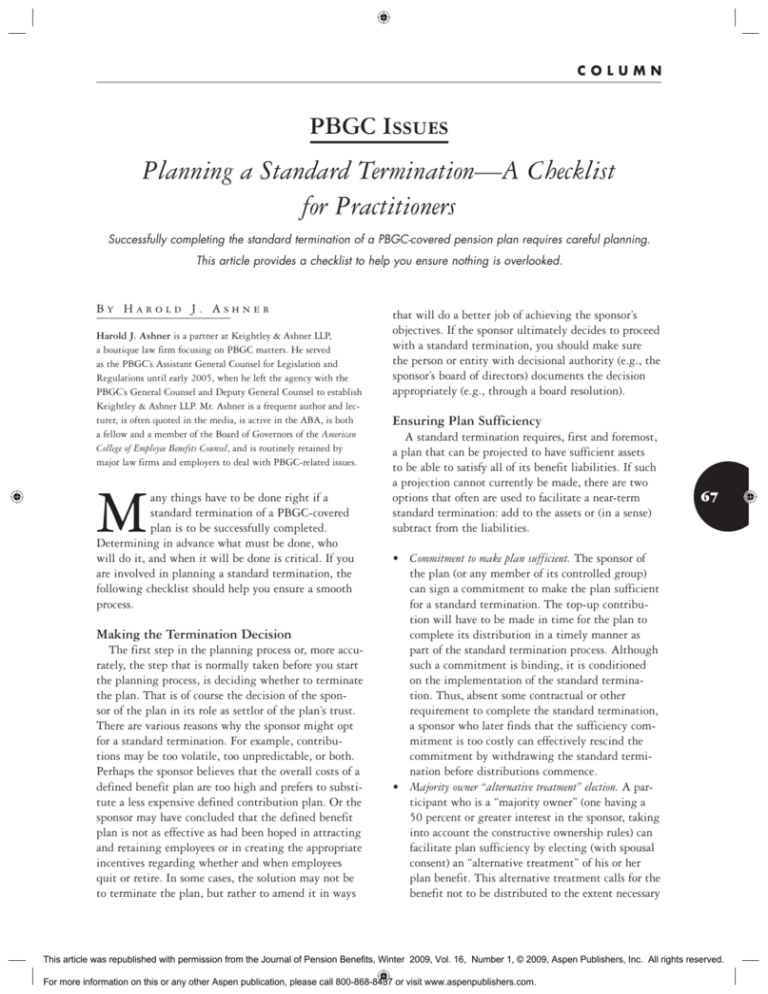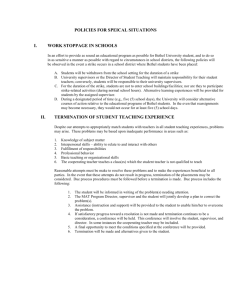
C O LUMN
PBGC Issues
Planning a Standard Termination—A Checklist
for Practitioners
Successfully completing the standard termination of a PBGC-covered pension plan requires careful planning.
This article provides a checklist to help you ensure nothing is overlooked.
By Harold J. Ashner
Harold J. Ashner is a partner at Keightley & Ashner LLP,
a boutique law firm focusing on PBGC matters. He served
as the PBGC’s Assistant General Counsel for Legislation and
Regulations until early 2005, when he left the agency with the
PBGC’s General Counsel and Deputy General Counsel to establish
Keightley & Ashner LLP. Mr. Ashner is a frequent author and lecturer, is often quoted in the media, is active in the ABA, is both
a fellow and a member of the Board of Governors of the American
College of Employee Benefits Counsel, and is routinely retained by
major law firms and employers to deal with PBGC-related issues.
M
any things have to be done right if a
standard termination of a PBGC-covered
plan is to be successfully completed.
Determining in advance what must be done, who
will do it, and when it will be done is critical. If you
are involved in planning a standard termination, the
following checklist should help you ensure a smooth
process.
Making the Termination Decision
The first step in the planning process or, more accurately, the step that is normally taken before you start
the planning process, is deciding whether to terminate
the plan. That is of course the decision of the sponsor of the plan in its role as settlor of the plan’s trust.
There are various reasons why the sponsor might opt
for a standard termination. For example, contributions may be too volatile, too unpredictable, or both.
Perhaps the sponsor believes that the overall costs of a
defined benefit plan are too high and prefers to substitute a less expensive defined contribution plan. Or the
sponsor may have concluded that the defined benefit
plan is not as effective as had been hoped in attracting
and retaining employees or in creating the appropriate
incentives regarding whether and when employees
quit or retire. In some cases, the solution may not be
to terminate the plan, but rather to amend it in ways
that will do a better job of achieving the sponsor’s
objectives. If the sponsor ultimately decides to proceed
with a standard termination, you should make sure
the person or entity with decisional authority (e.g., the
sponsor’s board of directors) documents the decision
appropriately (e.g., through a board resolution).
Ensuring Plan Sufficiency
A standard termination requires, first and foremost,
a plan that can be projected to have sufficient assets
to be able to satisfy all of its benefit liabilities. If such
a projection cannot currently be made, there are two
options that often are used to facilitate a near-term
standard termination: add to the assets or (in a sense)
subtract from the liabilities.
67
• Commitment to make plan sufficient. The sponsor of
the plan (or any member of its controlled group)
can sign a commitment to make the plan sufficient
for a standard termination. The top-up contribution will have to be made in time for the plan to
complete its distribution in a timely manner as
part of the standard termination process. Although
such a commitment is binding, it is conditioned
on the implementation of the standard termination. Thus, absent some contractual or other
requirement to complete the standard termination,
a sponsor who later finds that the sufficiency commitment is too costly can effectively rescind the
commitment by withdrawing the standard termination before distributions commence.
• Majority owner “alternative treatment” election. A participant who is a “majority owner” (one having a
50 percent or greater interest in the sponsor, taking
into account the constructive ownership rules) can
facilitate plan sufficiency by electing (with spousal
consent) an “alternative treatment” of his or her
plan benefit. This alternative treatment calls for the
benefit not to be distributed to the extent necessary
This article was republished with permission from the Journal of Pension Benefits, Winter 2009, Vol. 16, Number 1, © 2009, Aspen Publishers, Inc. All rights reserved.
For more information on this or any other Aspen publication, please call 800-868-8437 or visit www.aspenpublishers.com.
68
JOURNAL OF PENSION BENEFITS
to enable distribution of full benefit liabilities to
all other participants. If assets remain after all other
benefit liabilities are satisfied, the majority owner’s
benefit must be paid in full before there can be
any reversion to the sponsor or any distribution of
excess assets to other participants.
was frozen, if a decision about replacement benefits
has not yet been made, it should be made and communicated promptly to participants so as to minimize any
adverse employee relations impact associated with the
standard termination.
Developing a Communications Strategy
Another option is the “freeze-and-wait” approach,
where the sponsor freezes the plan (if not already frozen) in accordance with the ERISA Section 204(h)
notice requirements and hopes that ongoing contributions, perhaps aided by favorable investment experience and rising interest rates, will close the funding
gap over the next few years. Where lump sum distributions will be available, the sponsor might choose
to target a 2012 standard termination, when the
changes made by the Pension Protection Act of 2006
(“PPA”) to the interest rates used in calculating minimum lump sums—changes that result in lower lump
sums—will be fully phased in.
If plan sufficiency for all benefit liabilities is out of
reach and the sponsor and the other members of its
controlled group cannot afford to maintain the plan,
the only options for plan termination are a distress
termination initiated by the plan administrator or an
involuntary termination initiated by PBGC. These
kinds of terminations can be difficult to achieve and,
in any event, raise more complex issues that go well
beyond the scope of this article.
Dealing with Bargained Plans
A standard termination cannot proceed under Title
IV of ERISA where it would violate the terms and
conditions of an existing collective bargaining agreement. If the union initiates a formal challenge to the
termination, PBGC will not itself resolve the challenge. Instead, it will suspend the standard termination process so that the challenge can be resolved in
the appropriate labor relations forum. If you are dealing with a bargained plan, it is important early on to
evaluate whether such a challenge is likely and, if so,
how best to address that potential challenge (ideally
by obtaining the union’s consent) so that the standard
termination can proceed.
Deciding on Replacement Benefits
In some cases, the plan will have been frozen for
some time and the decision as to any replacement
benefits for participants (e.g., a new 401(k) plan or
enhanced benefits under an existing one) already has
been made. Regardless of whether or when the plan
Effective communication with the plan’s participants is not limited to what goes into the various required notices. It is important to keep them
informed as to why the plan is being terminated and
what to expect regarding the plan termination, their
benefits under the terminating plan, and any replacement benefits they may be getting. PBGC regulations
allow you to include additional information with a
required notice, provided that the additional information is not misleading. Plan a communications
strategy that takes advantage of this flexibility so that
participants will have the information you want them
to have, not just the information required by PBGC
regulations. Complete and effective communications
can go far in allaying the concerns of the plan’s participants regarding the future and security of their
benefits.
Dealing with Plan Assets
Once a decision is made to pursue a standard termination, it is time to revisit the plan’s investment
policy. The plan’s short-term time horizon, coupled
with the goal of ensuring sufficiency for all benefit
liabilities, may warrant a shift, for example, from
significant exposure to equities to an immunized bond
portfolio approach so as to guard against the risk that
falling interest rates or a steep drop in equity prices
will result in plan insufficiency.
Another concern is whether any illiquid assets, such
as real estate investments, can be liquidated in time to
complete the standard termination distribution within
the applicable time limits. It may be appropriate to
start liquidating such assets early in the standard
termination process so that cash will be available when
needed to satisfy benefit liabilities.
Certain expenses associated with the standard termination may be paid out of plan assets, assuming
the plan so permits. The key distinction is whether
the expenses are associated with the decision to terminate the plan, in which case they would be borne
by the sponsor, or are associated with the implementation of that decision, in which case they may be
payable by the plan to the extent they are reasonable
and necessary. It is helpful at the planning stage to
This article was republished with permission from the Journal of Pension Benefits, Winter 2009, Vol. 16, Number 1, © 2009, Aspen Publishers, Inc. All rights reserved.
For more information on this or any other Aspen publication, please call 800-868-8437 or visit www.aspenpublishers.com.
PBGC ISSUES
have a clear understanding of which expenses may be
paid from plan assets and, if so, whether they should
be. (Ultimately, the sponsor will be providing whatever funds will be needed to complete the standard
termination.)
The flip side of not having enough assets is the
“problem” of having too much. If the plan is likely
to have excess assets following satisfaction of all of its
benefit liabilities, it is important to determine at the
outset how the excess will be used. If a reversion to
the employer will not be permitted (whether because
the plan does not permit it or because the plan provision permitting it will not have been in place for the
required five-year period), be sure you understand how
the excess will be distributed among participants.
Where an employer reversion will be permitted, determine as part of the planning process how you intend
to deal with the excise tax on the reversion amount.
By establishing a qualified replacement plan or providing for pro rata benefit increases, you can reduce
the tax from 50 to 20 percent.
Evaluating Plan Amendment Options
Review plan provisions and recent statutory and
regulatory changes to determine whether plan amendments are necessary or appropriate. Those amendments
needed to retain the plan’s qualified status will top
your list, but many other plan amendment options
may be worth considering. For example:
• Allowing termination lump sums. If the plan does not
already provide an option for a consensual lump
sum upon plan termination, you may want to
add one. In deciding whether to do so, consider
the cost of lump sum distributions (taking into
account the phase-in of the PPA changes to the
interest rates used in calculating lump sums) as
compared to the cost of purchases of irrevocable
commitments (annuity contracts) from an insurer.
• Eliminating non-protected benefits. If cost is a significant concern, you may want to amend the plan
to eliminate ancillary benefits (e.g., life insurance
benefits) or other benefits that are not protected
under IRC Section 411(d)(6) and implementing
regulations.
• Freezing benefit accruals. If the plan is not already
frozen, you will almost certainly want to amend it
to freeze benefit accruals as of the proposed termination date (or as of an earlier date), regardless of
whether the standard termination is successfully
completed. This is an important “fail-safe” in case
69
it becomes necessary to defer the proposed termination date or to withdraw the standard termination and initiate a new one.
• Allocating residual assets among participants. You may
want to amend the plan to address the formula for
allocating residual assets among participants.
Regardless of whether the amendment you are
considering is necessary to meet a tax qualification
requirement, remember that PBGC rules on the
timing of the adoption of plan amendments in connection with a standard termination differ from IRS
rules. For tax qualification purposes, amendments may
be adopted until the end of the applicable remedial
amendment period, even if that is after the plan’s termination date. PBGC regulations, however, provide
that any amendment adopted after the plan’s termination date is disregarded to the extent it decreases
benefit values or eliminates or restricts optional forms
of benefit. Avoid potential problems with respect to
any amendments that could result in such a decrease,
elimination, or restriction by adopting them on or
before the plan’s proposed termination date.
There is an exception in PBGC regulations that
allows an amendment adopted after the plan’s termination date to decrease benefit values to the extent
the decrease is necessary to meet a tax qualification
requirement. PBGC interprets this exception narrowly, however. For example, assume an amendment
is adopted after the plan’s termination date to substitute the PPA assumptions (including the phase-in of
the interest assumptions for distributions in the 2008
through 2012 plan years) for the GATT assumptions
for purposes of calculating minimum lump sum values,
thereby decreasing them. PBGC would not allow the
plan to base its termination lump sums on the PPA
assumptions, notwithstanding that it was necessary for
the plan to adopt the PPA assumptions to meet tax
qualification requirements, because the plan could have
met those requirements by adding the PPA assumptions as an alternative basis and paying the greater of
the PPA-based or GATT-based lump sum. Thus, to the
extent the amendment eliminated the GATT basis for
calculating minimum lump sums, it was not “necessary” to meet tax qualification requirements.
When dealing with amendments substituting the
PPA lump sum assumptions for the GATT lump
sum assumptions, focus not only on the timing of the
amendment in relation to the termination date, but
also on the timing of the termination date in relation
to when the PPA changes became effective (i.e., the
This article was republished with permission from the Journal of Pension Benefits, Winter 2009, Vol. 16, Number 1, © 2009, Aspen Publishers, Inc. All rights reserved.
For more information on this or any other Aspen publication, please call 800-868-8437 or visit www.aspenpublishers.com.
70
first day of the 2008 plan year). If the termination date
was before the 2008 plan year, such an amendment—
even where adopted on or before the termination
date—is not effective. Thus, a standard termination
lump sum with a distribution date (which, for convenience, is assumed in this article to be the annuity
starting date) in or after the 2008 plan year would be
based on the GATT rather than the PPA assumptions.
On the other hand, if the termination date is in or after
the 2008 plan year, such an amendment adopted on or
before the termination date is effective. In such a case,
the applicable phase-in of the interest assumptions is
determined based on the plan year that contains the
distribution date rather than the plan year that contains the termination date, and the applicable mortality
table is the one specified by the Secretary of Treasury
on the termination date, taking into account projected
mortality improvements under the table through the
plan year containing the distribution date.
Updating Plan Records
Plan records need to be in good shape for the standard termination to proceed without a hitch. As you
plan, it is important to evaluate any data problems
and to determine when and how those problems can
be fixed so that benefit liabilities can be determined
in a timely manner. If the mailing list of the plan’s
participants and beneficiaries is out of date, now is the
time to make it current so that the notices of intent
to terminate and all later notices will reach their
intended recipients.
Searching for Missing Participants
If the plan is likely to have any missing participants, decide what steps you will take to meet PBGC’s
diligent search requirements. If there are any known
missing participants (e.g., because prior mailings were
returned as undeliverable), start the diligent search
process for them well before issuing notices of intent
to terminate so that you have a chance of finding them
in time to issue those notices properly. Any such steps,
such as use of a commercial locator service, can count
toward meeting the diligent search requirements provided they are taken no more than six months before
the notices of intent to terminate are issued.
Anticipating a Determination
Letter Application
Decide whether you will be applying to IRS for a
favorable determination letter upon plan termination.
In most cases, you will want to do so to guard against
JOURNAL OF PENSION BENEFITS
the risk that the termination would result in loss of the
plan’s qualified status. It is important to keep in mind,
however, that this will likely result in a loss of control
over the timing of the distribution in the standard termination. It is also important to recognize that PBGC,
in the event it audits the standard termination, will
take the position that it is in no way bound by anything IRS has decided as part of the determination letter process. In any event, if you anticipate applying for
a determination letter, make sure to factor into your
implementation schedule a realistic estimate of when
you expect to get it. Whether or not you apply for a
determination letter, remember to adopt all required
amendments, as well as all discretionary amendments
under which the plan has been operating, regardless of
how much time is afforded under a remedial amendment period for an ongoing plan.
Developing an Implementation Schedule
Develop a detailed schedule for implementing the
standard termination. Include target dates for at least
the following key stages of the standard termination
process:
• Earliest and latest dates of issuance of notices of
intent to terminate (60–90 days before the proposed termination date);
• Proposed termination date;
• Issuance of notices to interested parties if you will
be applying to IRS for a favorable determination
letter (7–21 days before the date of the application
if the notice is given by posting or in person, or
10–24 days before that date if given by mailing);
• Application for determination letter (by time of
filing Form 500 with PBGC);
• Issuance of notices of plan benefits (by time of
filing Form 500 with PBGC);
• Filing of Form 500 (“Standard Termination
Notice”) with PBGC (by the 180th day after the
proposed termination date);
• Issuance of election notices (30–180 days before
the date distribution commences; may be combined with notices of plan benefits);
• Issuance (if not already provided with the notice of
intent to terminate) of notices of annuity information
(no later than 45 days before the distribution date);
• Earliest permitted distribution date (the 61st day
after the date PBGC received the Form 500);
• Latest permitted distribution date (the 240th day
after the date PBGC received the Form 500 or, if
an application for a determination letter was filed
This article was republished with permission from the Journal of Pension Benefits, Winter 2009, Vol. 16, Number 1, © 2009, Aspen Publishers, Inc. All rights reserved.
For more information on this or any other Aspen publication, please call 800-868-8437 or visit www.aspenpublishers.com.
PBGC ISSUES
by the time of filing Form 500, the 120th day
after receipt of a favorable determination letter);
• Expected distribution date (or range of expected
distribution dates); and
• Filing of Form 501 (“Post-Distribution
Certification”) with PBGC (30 days after completion
of distribution of all benefit liabilities, but with penalty relief until 90th day after distribution deadline).
Using the schedule as your guide, make sure that
all those involved in the standard termination process
(e.g., plan administrator, actuary, attorney, accountant,
asset advisor, trustee) have a clear understanding of
what role each will play in ensuring that all required
steps are completed in a timely and compliant manner.
Evaluating Insurer Options
The selection of an insurer from whom to purchase
any necessary irrevocable commitments comes near
71
the end, rather than the beginning, of the standard
termination process. Nonetheless, it is often helpful
at the planning stage to begin to evaluate options for
selecting an insurer and to get at least a general sense
of the likely costs of irrevocable commitments (recognizing that those costs may change significantly as
interest rates change). Decide what steps should be
taken to ensure that the insurer selection will comply
with fiduciary standards and the guidance in DOL
Interpretive Bulletin 95-1 regarding selection of the
“safest available” insurer.
Conclusion
With proper planning, a standard termination process can be completed without problems. By identifying potential issues and concerns early on, you will
maximize the likelihood of completing the necessary
steps in a timely manner and of easily surviving any
PBGC audit of the standard termination. ■
This article was republished with permission from the Journal of Pension Benefits, Winter 2009, Vol. 16, Number 1, © 2009, Aspen Publishers, Inc. All rights reserved.
For more information on this or any other Aspen publication, please call 800-868-8437 or visit www.aspenpublishers.com.





